 | | | Switch to: Europe, USA, New Zealand, Antarctica Credit: NOAA/Ovation  Planetary K-index Planetary K-index
Now: Kp= 3 quiet
24-hr max: Kp= 3 quiet
explanation | more data
Interplanetary Mag. Field
Btotal: 5.57 nT
Bz: -1.04 nT south
more data: ACE, DSCOVR
Updated: Today at 1146 UT  Note: Coronal hole images are temporarily out of date because of a power outage at Stanford University where SDO images are processed.
Coronal Holes: 21 Jun 22 
There are no significant coronal holes on the Earthside of the sun. Credit: SDO/AIA  Noctilucent Clouds Noctilucent Clouds
Noctilucent cloud season has begun. NASA's AIM spacecraft detected the first NLCs of 2022 around the Arctic Circle on May 22nd. Switch view: Europe, USA, Asia, Polar Updated Jun22  SPACE WEATHER
NOAA Forecasts | | Updated at: 2022 Jun 22 2200 UTC FLARE | 0-24 hr | 24-48 hr | CLASS M | 25 % | 25 % | CLASS X | 05 % | 05 % |  Geomagnetic Storms: Geomagnetic Storms:
Probabilities for significant disturbances in Earth's magnetic field are given for three activity levels: active, minor storm, severe storm Updated at: 2022 Jun 22 2200 UTC Mid-latitudes | 0-24 hr | 24-48 hr | ACTIVE | 20 % | 10 % | MINOR | 05 % | 01 % | SEVERE | 01 % | 01 % | High latitudes | 0-24 hr | 24-48 hr | ACTIVE | 20 % | 15 % | MINOR | 30 % | 20 % | SEVERE | 25 % | 10 % | | | |  | | | | | | | | | | | Never miss another geomagnetic storm. Sign up for Space Weather Alerts and you'll receive a text message when magnetic storms erupt. Aurora your guides and professional astronomers use this service. You can, too! | | | MORNING PLANET SHOW: For the first time in almost 20 years, five naked-eye planets have lined up in the morning sky in order of their distance from the sun: Mercury, Venus, Mars, Jupiter and Saturn. This week the Moon will hop from planet to planet, producing a series of beautiful conjunctions. Set your alarm for dawn and enjoy the show! Sky maps: June 22, 23, 24, 25, 26. MID-LATITUDE NOCTILUCENT CLOUDS: On the summer solstice, June 21st, Charles Chiofar of Buckley, Washington, woke up before sunrise to check out the sky. "While taking photos of the planets, noctilucent clouds (NLCs) also put on a rather good display," he says. This is a 20 second exposure: 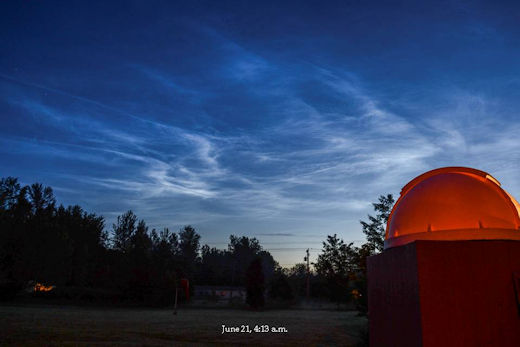
Chiofar's sighting marks the lowest latitude excursion of NLCs so far this year. Buckley is at +47o N. Usually, NLCs are most widespread during weeks around solstices--i.e., now. Sky watchers at mid-latitudes should be alert for these clouds of frosted meteor smoke; just before sunrise or after sunset is the best time to look. Realtime Noctilucent Cloud Photo Gallery
Free: Spaceweather.com Newsletter SPACEX MYSTERY, SOLVED: The mystery of SpaceX's "rocket powered auroras" has been solved. On Sunday morning, June 19th, SpaceX launched a Falcon 9 rocket from Cape Canaveral. Photographers accustomed to seeing these launches were surprised when something unusual happened. A red glow stretched across the Milky Way. It looked like the aurora borealis, as shown in this photo from Christopher Hoffman in Saint Mary's County, Maryland: 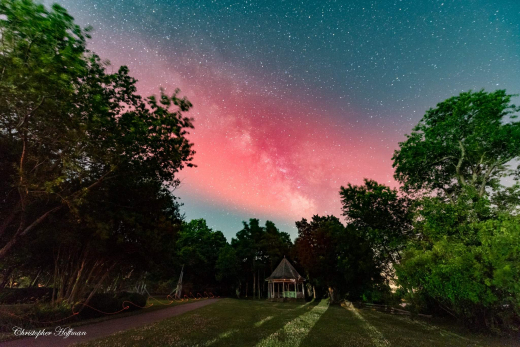
"I went out with some first time photographers to teach them how to set up their cameras for night sky photography," says Hoffman. "We took a 30 second exposure, and when the exposure was finished I saw this red glowing area covering the Milky Way." Photographers in New York, Ohio, North Carolina and Tennesee saw it, too. The glow appeared about 10 minutes after the Falcon 9 rocket lifted off, and many observers likened its appearance to auroras. However, there was no geomagnetic storm in progress. It had to be the rocket. What happened? Space physicist Jeff Baumgardner of Boston University has the answer: "This glow is probably the exhaust gasses from the rocket's 2nd stage causing the ionosphere to recombine quickly. This is a well studied phenomenon when rocket engines are firing in the altitude regime 200-250 km." 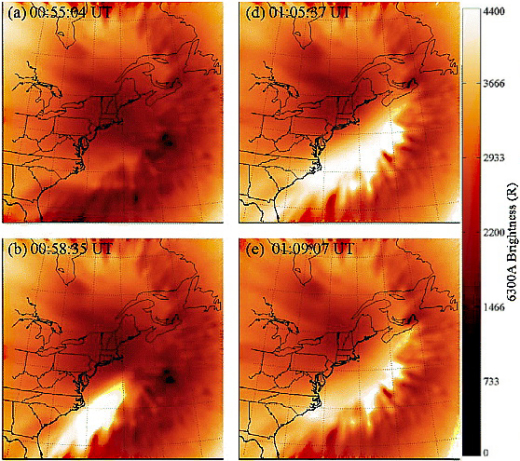
Above: A similar display of red light appeared over the eastern USA following the launch of a Titan IV rocket on April 30, 2005. [full story]
In simplified form, here is what happens: The upper atmosphere is filled with oxygen ions (O+). Of particular interest is the F-layer of the ionosphere, because it is rich in O+. When the Falcon 9 rocket reaches the F-layer, it adds water (H2O) and carbon dioxide (CO2) to the mix, spewing the molecules out of its engine. Oxygen ions are hungry for electrons, and the newly arriving molecules are eager to provide them. Electrons "re-combine" with oxygen, turning ions into atoms. As electrons cascade down the oxygen atom's energy levels, they emit red photons at a wavelength of 6300 Å--the same color as red auroras. more images: from Josh Thum of Sevierville, Tennessee; from Brenda Calinawan of Kortright, New York; from David Cortner of Rutherford College, NC Realtime Space Weather Photo Gallery
Free: Spaceweather.com Newsletter "I LOVE YOU FOREVER" MOONSTONE PENDANT: Are you looking for a far-out gift? Consider the "I Love You Forever" Moonstone. This one hitched a ride to the stratosphere onboard a cosmic ray research ballooin on May 13, 2022: 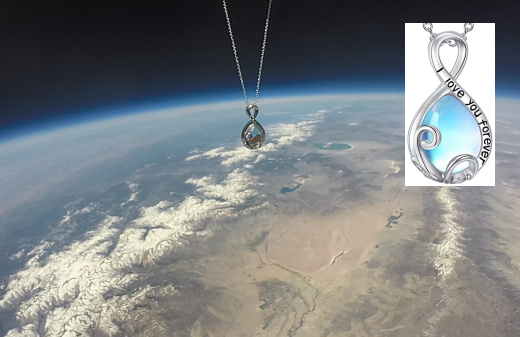
You can have it for $162.95. The moonstone's sterling silver infinity wrap is inscribed with the words "I love you forever." It makes a great anniversary or birthday gift. The moonstone comes with a greeting card showing the pendant in flight, telling the story of its trip to the edge of space and back again. Far Out Gifts: Earth to Sky Store
All sales support hands-on STEM education
Realtime Aurora Photo Gallery
Free: Spaceweather.com Newsletter
Every night, a network of NASA all-sky cameras scans the skies above the United States for meteoritic fireballs. Automated software maintained by NASA's Meteoroid Environment Office calculates their orbits, velocity, penetration depth in Earth's atmosphere and many other characteristics. Daily results are presented here on Spaceweather.com. On June 22, 2022, the network reported 7 fireballs.
(7 sporadics)  In this diagram of the inner solar system, all of the fireball orbits intersect at a single point--Earth. The orbits are color-coded by velocity, from slow (red) to fast (blue). [Larger image] [movies] Potentially Hazardous Asteroids ( PHAs) are space rocks larger than approximately 100m that can come closer to Earth than 0.05 AU. None of the known PHAs is on a collision course with our planet, although astronomers are finding new ones all the time. On June 22, 2022 there were 2279 potentially hazardous asteroids.
 | Recent & Upcoming Earth-asteroid encounters: | Asteroid | Date(UT) | Miss Distance | Velocity (km/s) | Diameter (m) | | 2022 MC | 2022-Jun-17 | 5.4 LD | 14.8 | 62 | | 2022 LA3 | 2022-Jun-18 | 7.4 LD | 7.2 | 22 | | 2022 MH | 2022-Jun-19 | 1.2 LD | 11.2 | 12 | | 2022 MB | 2022-Jun-19 | 16.5 LD | 7.5 | 53 | | 2022 MM | 2022-Jun-21 | 1.2 LD | 21.3 | 29 | | 2022 LX | 2022-Jun-22 | 10.4 LD | 10.1 | 35 | | 2022 LS1 | 2022-Jun-23 | 18.9 LD | 9.9 | 35 | | 2022 LB2 | 2022-Jun-25 | 5 LD | 8.3 | 23 | | 2022 LV | 2022-Jun-25 | 2 LD | 3.6 | 22 | | 2015 WP2 | 2022-Jun-26 | 18.5 LD | 11.4 | 3 | | 2022 MD | 2022-Jun-26 | 14 LD | 8.3 | 54 | | 2022 MQ | 2022-Jun-27 | 7.5 LD | 12.1 | 95 | | 2022 MP | 2022-Jun-27 | 6.6 LD | 7.7 | 57 | | 2022 ML | 2022-Jun-27 | 12.9 LD | 9.1 | 31 | | 2022 MJ | 2022-Jun-27 | 14 LD | 12.2 | 54 | | 2022 MF | 2022-Jul-02 | 14.8 LD | 12.1 | 37 | | 2022 JE1 | 2022-Jul-03 | 8.6 LD | 5.6 | 74 | | 2021 EL4 | 2022-Jul-05 | 19.8 LD | 9.5 | 25 | | 2015 OQ21 | 2022-Jul-12 | 18.3 LD | 6.6 | 9 | | 2022 LR1 | 2022-Jul-16 | 9.3 LD | 4.7 | 42 | | 2022 KY4 | 2022-Jul-17 | 15.9 LD | 7.6 | 91 | | 2021 OT | 2022-Jul-17 | 16.5 LD | 11.2 | 20 | | 349068 | 2022-Jul-19 | 17.6 LD | 22.9 | 756 | | 2017 RX2 | 2022-Jul-24 | 17.2 LD | 14.2 | 17 | | 2016 CZ31 | 2022-Jul-29 | 7 LD | 15.6 | 129 | | 531944 | 2022-Jul-30 | 18.2 LD | 5.9 | 192 | | 2020 PP1 | 2022-Aug-01 | 13.1 LD | 3.7 | 17 | | 2020 PN1 | 2022-Aug-03 | 9.7 LD | 4.6 | 29 | | 2015 FF | 2022-Aug-12 | 11.2 LD | 9.2 | 17 | Notes: LD means "Lunar Distance." 1 LD = 384,401 km, the distance between Earth and the Moon. 1 LD also equals 0.00256 AU. MAG is the visual magnitude of the asteroid on the date of closest approach. | | Cosmic Rays in the Atmosphere | SPACE WEATHER BALLOON DATA: Almost once a week, Spaceweather.com and the students of Earth to Sky Calculus fly space weather balloons to the stratosphere over California. These balloons are equipped with sensors that detect secondary cosmic rays, a form of radiation from space that can penetrate all the way down to Earth's surface. Our monitoring program has been underway without interruption for 7 years, resulting in a unique dataset of in situ atmospheric measurements. Latest results (Nov. 2021): Our balloons have just measured a sudden drop in atmospheric radiation. It happened during the strong geomagnetic storms of Nov. 3-4, 2021. Here are the data: 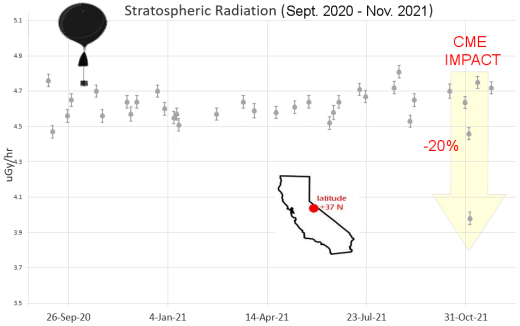
This is called a "Forbush decrease," named after American physicist Scott Forbush who studied cosmic rays in the early 20th century. It happens when a CME from the sun sweeps past Earth and literally pushes cosmic rays away from our planet. Radiation from deep space that would normally pepper Earth's upper atmosphere is briefly wiped out. We have measured Forbush decreases before. For example, here's one from Sept. 2014. The Forbush Decrease of Nov. 3-4, 2021, was the deepest in the history of our 7-year atmospheric monitoring program. Radiation levels in the stratosphere over California dropped nearly 20%, more than doubling the previous record from our dataset. En route to the stratosphere, our sensors also pass through aviation altitudes, so we can sample radiation where planes fly. This plot shows how the Forbush decrease was restricted to the stratosphere; it did not affect lower levels of the atmosphere: 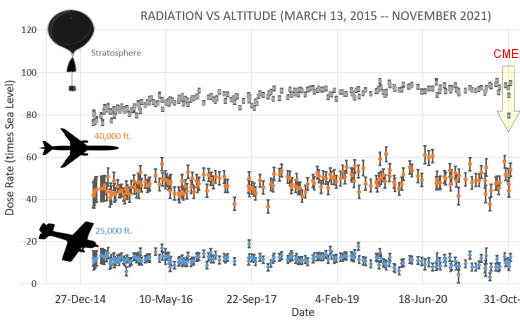
The dose rates shown above are expressed as multiples of sea level. For instance, we see that boarding a plane that flies at 25,000 feet exposes passengers to dose rates ~10x higher than sea level. At 40,000 feet, the multiplier is closer to 50x. The higher you fly, the more radiation you will absorb. .Who cares? Cosmic rays are a surprisingly "down to Earth" form of space weather. They can seed clouds, trigger lightning, and penetrate commercial airplanes. According to a study from the Harvard T.H. Chan school of public health, crews of aircraft have higher rates of cancer than the general population. The researchers listed cosmic rays, irregular sleep habits, and chemical contaminants as leading risk factors. Somewhat more controversial studies (#1, #2, #3, #4) link cosmic rays with cardiac arrhythmias and sudden cardiac death. .Technical notes: The radiation sensors onboard our helium balloons detect X-rays and gamma-rays in the energy range 10 keV to 20 MeV. These energies span the range of medical X-ray machines and airport security scanners. Data points in the first graph ("Stratospheric Radiation") correspond to the peak of the Regener-Pfotzer maximum, which lies about 67,000 feet above central California. When cosmic rays crash into Earth's atmosphere, they produce a spray of secondary particles that is most intense at the entrance to the stratosphere. Physicists Eric Regener and Georg Pfotzer discovered the maximum using balloons in the 1930s and it is what we are measuring today. | | The official U.S. government space weather bureau | | | The first place to look for information about sundogs, pillars, rainbows and related phenomena. | | | Researchers call it a "Hubble for the sun." SDO is the most advanced solar observatory ever. | | | 3D views of the sun from NASA's Solar and Terrestrial Relations Observatory | | | Realtime and archival images of the Sun from SOHO. | | | information about sunspots based on the latest NOAA/USAF Active Region Summary | | | from the NOAA Space Environment Center | | | fun to read, but should be taken with a grain of salt! Forecasts looking ahead more than a few days are often wrong. | | | from the NOAA Space Environment Center | | | the underlying science of space weather |  | Going above and beyond to provide the best homes listings in the Comox real estate market to keep you up to date and informed |  | BestCSGOGambling is the best site for everything related to CSGO gambling on the web |  | To find reviews of new online casino sites in the UK try The Casino DB where there are hundreds of online casino reviews complete with bonuses and ratings. Alternatively, Online-Casinos.xyz is another massive directory of online casinos listing sites for the UK and Worldwide. Casinos that offer Rupees for bonuses are very generous to Indian players. Find the best online casinos in India at AllCasinos.in Looking for a new online casino? Try Casimpo the new site dedicated to making online casino simple, or check out the new Avenger Slots Casino and Ace Online Casino with over 500 online slots and casino games. |  | One of the most popular casino games is the Book Of Dead Slot based on ancient Egyptian text, you can find all the casinos with spins at bookofdeadslotsites.com. |  | When looking for casinos to play online when the weather is bad, you can try casino online trucchi for Italian games. If you are not from Finland you can try the Swedish page Svenska casino online to find suitable games, check out svenskacasinoonline.net. Always check your local laws before playing with real money. |  | Looking for sports betting companies not registered on GamStop? CasinoGap has presented a list of sites not on GamStop available for UK players. Check and bet online! Would you like to bet at sites not using GamStop? Look at a list of NonStopCasino sites for online betting that aren't on GamStop. Top-rated bookmakers ever! | | | These links help Spaceweather.com stay online. Thank you to our supporters! | | | | | | | | |  | |  |   | ©2021 Spaceweather.com. All rights reserved. This site is penned daily by Dr. Tony Phillips. | |

